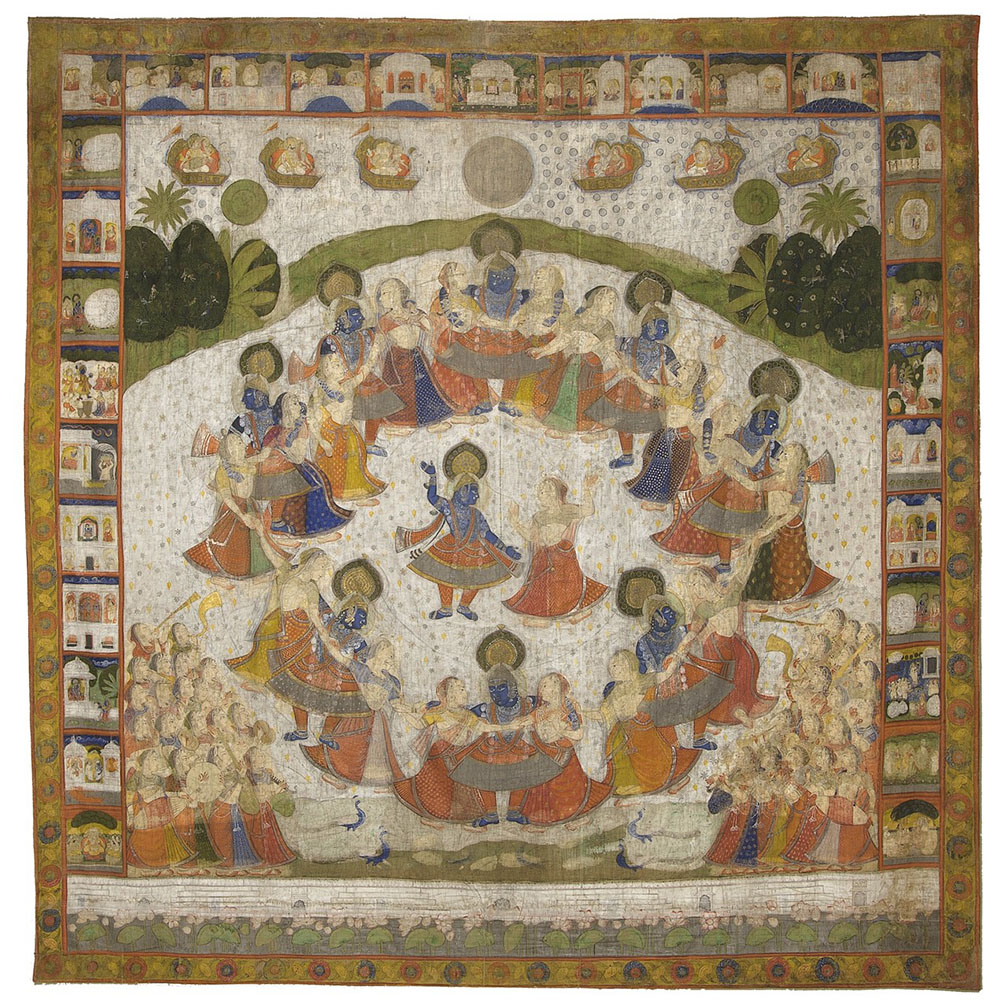
Krishna Dances with the Cowherd Women, circa 1850–1900, India; Rajasthan, Nathadwara, opaque watercolors, gold, and silver on cotton, Alice Bimel Endowment for Asian Art, 2018.115, 118 1/8 x 118 1/8 in. (300 x 300 cm)
Verbal Description
Hello, my name is Anu Mitra. I am docent at the Cincinnati Art Museum. I will be reading the verbal description for Krishna Dances with the Cowherd Women in Beyond Bollywood: 2000 Years of Dance in Art.
The Cincinnati Art Museum’s Krishna Dances with the Cowherd Women is a painting made with opaque watercolors, gold and silver on cotton. The date is circa 1850 to 1900. It is from India, specifically Rajasthan, Nathadwara. It is supported by the Alice Bimel Endowment for Asian Art. The accession number is 2018.115.
This square painting entitled, Krishna Dances with the Cowherd Women, is approximately 300 by 300 centimeters wide. It was painted with opaque watercolors in blue, red, yellow, green and white hues, gold, and silver on cotton. At the top and sides of the painting, a rectangular border resembling a film strip depicts 31 scenes from Krishna’s life. Below the scenes at the top-center, a silver circular moon sits atop a white background. Three golden chariots float to the left and right of the moon respectively. Inside sit various figures with golden halos depicting the gods witnessing the divine scene below. An upside-down, U-shaped strip of moss green separates the heavens above from the earth below. This signifies the horizon line. Sprouting from the left and right sides of the earth are clumps of trees in various shades of green, some within which brown and gray monkeys frolic. Below the moon, Krishna faces the viewer; his skin is a radiant cobalt blue. On his head is a golden halo framed by his characteristic green peacock tail headdress. His chest is bare with the exception of crimson-red scarves on his left and right shoulders that cross at his skirted garment, below which he wears red pants. His bare blue feet are planted on a white background dotted with canary-yellow and silver flowers. Krishna is flanked by two women. His blue arms are wrapped around each of their shoulders. Their heads are draped with semitransparent headscarves. They wear short, fitted blouses that expose their midriffs and saris in crimson-red and canary-yellow hues.
Seven additional versions of Krishna dance in various poses with two cowherd women each, forming a wide circle. At the center of the circle is Krishna again. He dances with his right arm up, left arm down, gazing directly at the one cowherd woman who dances with him here within the center of the circle; she mirrors his gaze and pose. At the bottom-center of the circle, Krishna dances with two partners on a white ground. Below the circle dance, two crimson-blue peacocks flank him on each side. To his left and right, 18 women musicians in triangular formations play various instruments, such as drums and cymbals. Below them and across the length of the painting, a white structure with steps lead down to a moss-green pond with pale pink lotus flowers.
Label Text
Hello, my name is Anu Mitra. I am docent at the Cincinnati Art Museum. I will be reading the label for Krishna Dances with the Cowherd Women in Beyond Bollywood: 2000 Years of Dance in Art.
The Cincinnati Art Museum’s Krishna Dances with the Cowherd Women is a painting made with opaque watercolors, gold and silver on cotton. The date is circa 1850 to 1900. It is from India, specifically Rajasthan, Nathadwara. It is supported by the Alice Bimel Endowment for Asian Art. The accession number is 2018.115.
As described in the Bhagavata Purana, a religious literary text recounting the stories of the Hindu god Vishnu, the god Krishna, a manifestation of Vishnu, joins in amorous play with the women of a cowherd village, who have left their families to join him in a moonlit forest. The women grow overconfident, and, to teach them a gentle lesson, Krishna vanishes. Before long though, again using the divine power of illusion, he reappears in their midst and multiplies himself so that each cowherd woman can be close to him. Their dance, the rasamandala, often depicting multiple visions of Krishna, is one of longing and connection, and it resonates in earthly and divine realms. He joins the circle dance of the cowherd women and appears again dancing in the center with a single woman. Surrounding the rasamandala are little scenes of other episodes in Krishna’s life, and along the lower edge of the image is a wall with steps leading to a lotus-filled stream.
